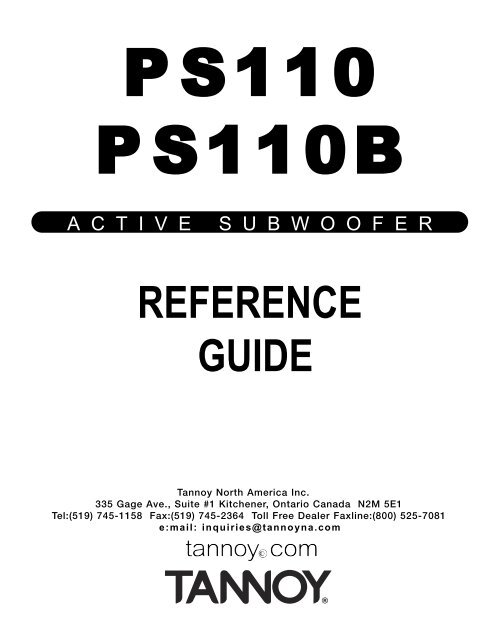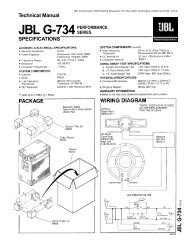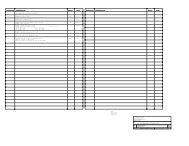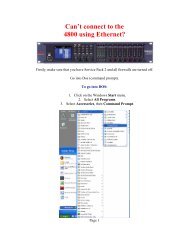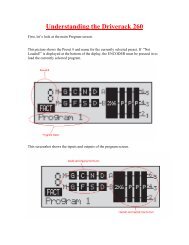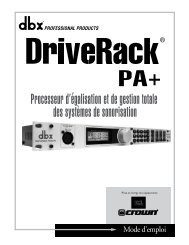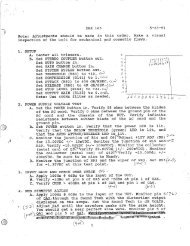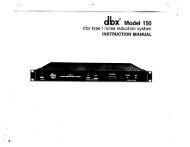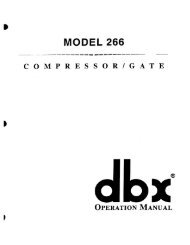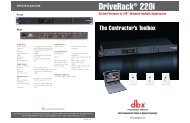You also want an ePaper? Increase the reach of your titles
YUMPU automatically turns print PDFs into web optimized ePapers that Google loves.
P S110<br />
P S110B<br />
A C T I V E S U B W O O F E R<br />
REFERENCE<br />
GUIDE<br />
Tannoy North America Inc.<br />
335 Gage Ave., Suite #1 Kitchener, Ontario Canada N2M 5E1<br />
Tel:(519) 745-1158 Fax:(519) 745-2364 Toll Free Dealer Faxline:(800) 525-7081<br />
e:mail: inquiries@tannoyna.com
1.0 Introduction<br />
The introduction will be short because we know that you want to<br />
get this subwoofer up and running as soon as possible. But,<br />
there are some important things you need to know before undertaking<br />
the unpacking and connecting process. This subwoofer<br />
has features that you need to be familiar with prior to installation<br />
to get the best perfor<strong>man</strong>ce.<br />
2.0 Unpacking your Subwoofer<br />
After opening the box, check the unit for shipping damage before<br />
connecting to the AC supply and note if any damage relates to<br />
any holes or crushing of the outer carton. There are no rattles or<br />
loose pieces inside the subwoofer system by design, so if you<br />
hear anything that sounds inappropriate for a powered subwoofer<br />
while unpacking it, stop now, and check the carton for signs of<br />
damage. If damage has occurred, contact your freight carrier<br />
right away and have them register your damage claim.<br />
3.0 Placement of the Subwoofer<br />
The subwoofer is a compact device, which allows the unit to be<br />
easily placed where it can provide optimum perfor<strong>man</strong>ce. As part<br />
of the placement process, the perfor<strong>man</strong>ce can be fine-tuned by<br />
adjusting the user controls provided. You only have to do this the<br />
first time you set your system up. Once the balance is set<br />
between the subwoofer and the main speakers, the installation is<br />
complete. The general rule for placement is between the left and<br />
right channels in a two channel system or under the center channel<br />
in a 5.1 or other surround system. If two subwoofers are<br />
used, they are ideally positioned under, or close to the front left<br />
Example<br />
3 Room Boundary<br />
(2 Walls and 1 Floor = +6 dB)<br />
and front right main<br />
speakers.<br />
The governing factor in<br />
bass response heard at a<br />
given location in any<br />
room, are room modes. In<br />
addition, it is important to<br />
remember that a corner<br />
position offers the best<br />
chance of exciting the most room modes (diagonal, orthogonal,<br />
and axial), but this also changes the loading on the subwoofer<br />
which increases the amount of bass output. Placing the subwoofer<br />
in a corner (two walls and a floor) gives another 3 dB<br />
more low frequency energy over the two-boundary location, for a<br />
total of 6 dB over the unit in the middle of the floor. When you’re<br />
setting things up the first time, adjust the subwoofer level for the<br />
various room positions you try, keeping the overall system balance<br />
the same. The point of playing with the subwoofers room<br />
placement is to get a smooth and even bass response, rather<br />
than just getting lots of low frequency sound.<br />
If you’re using Tannoy main speakers, you may want to consider<br />
experimenting, using the closed cell reflex port foam plugs that<br />
were originally included in the speaker packaging. This will help<br />
tighten up the mid bass (80 Hz+) perfor<strong>man</strong>ce, since we don’t<br />
need the ports to enhance the bass below 80 Hz. This plug is a<br />
pressure fit, so it can be removed at a later date if required. Here<br />
are some additional tips that will help you get the best during setup:<br />
Experiment with the subwoofer features<br />
Make sure you’re not being impressed with more bass instead<br />
of smooth bass<br />
Don’t rely on a one third Octave RTA (Real Time Analyzer) to<br />
look for accurate guidance on level adjustment, or for room mode<br />
response at any specific position. It doesn’t have the time or frequency<br />
capability. The best way to listen is with a progression of<br />
low frequency notes. Are there drastic variations in the level of<br />
those notes? If they come out of the signal source at the same<br />
level, you can be sure that any problems are room related. If one<br />
listening position seems to provide significant variations, try<br />
another position several feet away. Because the wavelength of<br />
bass frequencies is quite long, it usually takes a change of position<br />
equal to a good fraction of the wavelength to hear the difference.<br />
You also want to strive for a large listening area. It doesn’t help<br />
to have a point in your listening space be perfect, but have that<br />
point be so small that you can’t get both ears into it at the same<br />
time. Every listening situation will be different, and we can’t offer<br />
more specific guidance on positioning than experiment and listen<br />
to material you trust.<br />
A subwoofer is an excellent tool for finding <strong>new</strong> sources of rattles<br />
and buzzes in the listening area. Because there is a concentrated<br />
low frequency source involved, nearby objects, such as wall panels,<br />
equipment cover plates, and other objects may become excited and<br />
pollute your systems perfor<strong>man</strong>ce. You need to track down each rattle<br />
and buzz and correct it at the source of the problem.<br />
4.0 Installation<br />
Sit the subwoofer in, or close to, where you believe its final position<br />
will be. Make sure you have easy access to the amplifier<br />
panel and controls. Plug the subwoofer into a wall outlet, preferably<br />
the same outlet, or at least the same circuit as your main<br />
speaker amplifier. Connect the signal source outputs to the input<br />
connectors of your subwoofer. Here is where you have two choices:<br />
Note: For the <strong>PS110</strong> version the following options also apply to<br />
using the speaker level wiring option. However, speaker level<br />
needs to be fed to the subwoofer from a two channel amplifier,<br />
not a line level signal from a signal source. The speaker wires on<br />
the subwoofer output side will go directly to the main speakers’<br />
inputs, not the main speakers’ amplifier (fig. 1).<br />
- +<br />
Right Speaker Out<br />
AMPLIFIER<br />
-<br />
Left Speaker Out<br />
Figure 1<br />
Speaker level setup using<br />
internal high pass filter.<br />
+<br />
IN OUT<br />
LEFT RIGHT<br />
+<br />
Speaker Level IN<br />
-<br />
-<br />
High Pass OUT<br />
+<br />
<strong>PS110</strong><br />
a: (Recommended) Another set of cables can be used to connect<br />
the subwoofer outputs to the L and R inputs of the main speaker<br />
amplifier. Please, don’t use cheap cables to connect the subwoofer.<br />
Buy quality components for your audio installation. It will<br />
pay off in the final experience. Using this connection method<br />
allows use of the subwoofers built-in high pass filter network to<br />
provide smooth transition of frequencies between the subwoofer<br />
and the main speaker system (<strong>PS110</strong> fig. 2, <strong>PS110</strong>B fig. 3).<br />
LEFT<br />
RIGHT<br />
Right<br />
Speaker<br />
-<br />
Right<br />
Speaker<br />
+<br />
Left<br />
Speaker<br />
+<br />
Left<br />
Speaker<br />
-
Figure 2<br />
Line level<br />
setup for<br />
<strong>PS110</strong> suing<br />
internal high<br />
pass filter.<br />
Out<br />
Left<br />
Out<br />
Right<br />
Out<br />
A/V RECEIVER<br />
OR<br />
SURROUND PROCESSOR<br />
Signal Source<br />
Figure 3<br />
Line level setup for<br />
<strong>PS110</strong>B using internal<br />
high pass filter.<br />
Out<br />
Left Right<br />
+<br />
Speaker Level IN<br />
Speaker Level OUT<br />
+<br />
AMPLIFIER<br />
Right Speaker<br />
Left Speaker<br />
b: (Optional) You may choose to allow the main speaker systems<br />
to operate full bandwidth, in which case you will not require the<br />
cables from the subwoofer outputs to the main speaker amplifier<br />
inputs. This approach does not high pass your main speakers<br />
and may or may not offer the best perfor<strong>man</strong>ce characteristics.<br />
Some experimentation will be required to achieve optimum<br />
results. (<strong>PS110</strong> fig. 4, <strong>PS110</strong>B fig 5).<br />
Figure 4<br />
Setup for discrete subwoofer<br />
channel for <strong>PS110</strong><br />
figure 5<br />
Setup for<br />
discrete<br />
subwoofer<br />
channel for<br />
<strong>PS110</strong>B<br />
Out<br />
Signal Source<br />
Out Out<br />
In In<br />
Main Speaker<br />
Amplifier<br />
Out Out<br />
Ensure that your left and right channels have been connected<br />
correctly through the chosen signal chain. Turn the gain control<br />
to minimum. Turn the subwoofer amplifier "On" and verify the<br />
LED is illuminated, indicating power is present. Note that the unit<br />
features an auto on/off circuit, which will turn the subwoofer off if<br />
there is no input signal for more than two minutes (indicated by<br />
the green LED turning to red). The sub will instantaneously turn<br />
on again, (indicated by the red LED turning green) as soon as an<br />
input signal is received. Start your program material and adjust<br />
your main speakers to the normal listening level. If you have high<br />
passed the main speakers, do not be alarmed that they sound<br />
thinner, all the energy below 80 Hz out of them for use by the subwoofer.<br />
In<br />
-<br />
-<br />
Right<br />
In<br />
<strong>PS110</strong><br />
L<br />
Input<br />
High Pass<br />
Output<br />
<strong>PS110</strong><br />
Out<br />
Left<br />
Right<br />
R<br />
Sub Out<br />
Left<br />
In<br />
A/V RECEIVER<br />
OR<br />
SURROUNG PROCESSOR<br />
<strong>PS110</strong><br />
L<br />
Input<br />
High Pass<br />
Output<br />
<strong>PS110</strong><br />
Right<br />
Out<br />
Left<br />
Out<br />
AMPLIFIER<br />
IN<br />
OUT<br />
IN<br />
OUT<br />
Main<br />
Speakers<br />
IN OUT<br />
Left<br />
Right<br />
Left Right<br />
+<br />
Speaker Level IN<br />
-<br />
-<br />
Speaker Level OUT<br />
+<br />
R<br />
Main<br />
Speakers<br />
Now, adjust the subwoofer gain control until you’re satisfied with<br />
a suitable level to match the main speakers. If something isn’t<br />
working at this stage, you can go ahead to the troubleshooting<br />
section, get things running, and then come back to find out how<br />
to make it work even better.<br />
5.0 Adjustable controls<br />
a: Sub Level (Gain Control)<br />
Adjusts the level of the subwoofer without affecting the signal<br />
level that goes to your main speaker amplifier. Because the subwoofer<br />
has an integral crossover filter, this will also act as a bass<br />
shelving control for your complete loudspeaker system. While it is<br />
tempting to turn the subwoofer levels up, it is there to reproduce<br />
low frequencies with less effort, and lower distortion, than the<br />
main speakers alone can achieve. The most important thing is to<br />
maintain a balanced audio spectrum.<br />
b: Crossover Frequency (Variable Low Pass Filter)<br />
This adjusts the crossover point for the subwoofer. In this system,<br />
that high pass filter point is fixed at 12 dB / Octave at 80 Hz.<br />
The variable low pass filter has a range of 40 Hz to 150 Hz at a<br />
24 dB / Octave slope, which allows you to adjust the amount of<br />
overlap in the operating range of the subwoofer by about half an<br />
octave. As you adjust the level of the subwoofer relative to the<br />
main speakers, you will find that you need to adjust the low pass<br />
filter point to avoid having a bump or hole in the bass response<br />
at the 80 Hz crossover point. While you could think of this as a<br />
bass control of sorts, it’s really there to help match the perfor<strong>man</strong>ce<br />
of your main speakers.<br />
c: Crossover Mode<br />
Overrides the subwoofer internal low pass filter in the "all pass"<br />
position. The "all pass" switch position can be used when experimenting<br />
with a discrete subwoofer channel arrangement. Careful<br />
and thoughtful use of the controls are required to achieve the<br />
best results.<br />
For certain music and film production applications, it is <strong>man</strong>datory<br />
to run the L.F.E. (Low Frequency Effects) information through<br />
an outboard proprietary production DSP unit. In this situation, it<br />
is a requirement that the subwoofer being used has a linear frequency<br />
response up to 300 Hz. This can be achieved by switching<br />
the crossover mode switch to the "all pass" position, which<br />
overrides the subwoofers internal low pass filter. When no outboard<br />
DSP processor is <strong>man</strong>dated, the internal low pass filter<br />
must be engaged, (switch in the low pass mode) to operate the<br />
internal low pass crossover frequency feature.<br />
d: LF Boost<br />
This control offers the user the ability to boost the extreme low<br />
frequency energy below 63 Hz, up to a maximum level of 4 dB in<br />
a linear shelf mode. The maximum boost is obtained by turning<br />
the adjustment knob fully clockwise. The boost is eliminated once<br />
the knob is returned to the full counter-clockwise position. This<br />
feature is to enhance extreme low frequencies for maximum<br />
effects. As with all equalization, we advise its use in moderation.<br />
e: Phase Switch<br />
Depending on the distance that your subwoofer is placed from your<br />
main speakers, it may be necessary to reverse the phase of the<br />
subwoofer. This is achieved by simply moving the switch to the<br />
180 degree position. In most cases, you will find that the main<br />
speakers will work best in the 0 degree position. In any case, trying<br />
both positions of the switch will allow for quick reference. The switch<br />
is in the correct position for your setup when the low frequency<br />
output is greatest at, and below, the crossover point selected.
6.0 Protection System<br />
Because accidents happen, this subwoofer system is equipped<br />
with a protection limiter to prevent the amplifier from operating in<br />
a sustained clipping condition, or at a level that may cause damage<br />
to the low frequency drive unit due to over-excursion.<br />
Because the subwoofer amplifier has a limiter, there isn’t a clip<br />
light on the amplifier to indicate when it is in distress. This protection<br />
system allows the woofer to deliver its rated peak SPL of<br />
110 dB without compromise. If a bass drum or bass guitar doesn’t<br />
get any louder when you turn it up, and is starting to sound<br />
squashed or flat, then you are probably operating into the limiter.<br />
If you find that you are running into the limiter on a regular basis,<br />
you need to consider two or more subwoofers within the system.<br />
7.0 Care of the Subwoofer<br />
The subwoofer is finished with a vinyl covering that resists most<br />
common liquids, and can be cleaned with a damp cloth, or mild<br />
cleaner like Windex©. Avoid wetting the drive unit cone material<br />
during any cleaning effort. It would be preferable if you try to<br />
keep friends and neighbors from placing beverages on the subwoofer.<br />
Do not place the unit near a heater or forced air outlet, as this<br />
may impair the ability of the internal amplifier to dissipate heat<br />
and may harm the finish. The unit requires adequate air volume<br />
or space around it.<br />
8.0 Troubleshooting<br />
If you’re reading this, it is because no sound is coming out of<br />
your <strong>new</strong> powered subwoofer. Here are some of the easy ways<br />
to remedy problems.<br />
a: No sound comes out<br />
Check that the subwoofer powers up by looking for the illuminated<br />
LED. If the LED is not illuminated, check that the AC outlet is<br />
live by using a voltmeter, a circuit tester, or a lamp. If there is no<br />
power, consult a qualified electrician.<br />
If the AC outlet is live, and the amplifier is still not powered,<br />
check that the power switch is in the "On" position. If the unit is<br />
still not powered up, unplug the unit, remove and test the fuse on<br />
the rear control panel with a continuity tester. If blown, replace<br />
with a <strong>new</strong> fuse of the same specified value. If the unit still refuses<br />
to power up, call your dealer or local Tannoy distributor.<br />
If the unit is powered up, check the level control to ensure that it is<br />
not in the minimum position. Check that the signal from the<br />
source components is getting as far as the subwoofer. If there is<br />
signal present on the cables at the subwoofer inputs, the power is<br />
on, and the level control is up and no sound comes out, then this<br />
is a significant problem and should be referred to your dealer or<br />
local Tannoy distributor.<br />
b: Distorted sound comes out<br />
Is the subwoofer bass the only distorted sound, or are the main<br />
speakers distorted as well? Check the signal quality at the subwoofer<br />
input by connecting these cables directly into the main<br />
speaker amplifier inputs. If the sound is still distorted with only<br />
the main speakers on, the problem is in the source. If missing out<br />
the subwoofer eliminates the distortion, check the cables from<br />
the subwoofer to the main speaker amplifier. If the subwoofer is<br />
the only distorted sound, determine if it is distorted at any level<br />
setting. If it only happens at high output levels, then it may be<br />
that you are driving the system too hard. Extremely high input<br />
levels may overload the input to the limiter. If you have eliminated<br />
the possibility of bass distortion in the source material, and confirmed<br />
that the unit is not being over driven, then this too is a significant<br />
problem and should be referred to your dealer or local<br />
Tannoy distributor.<br />
9.0 Specifications<br />
LOUDSPEAKER SECTION<br />
Frequency Response: -3 dB 31 Hz -150 Hz (-10 dB @ 21 Hz)<br />
Bass unit diameter: 10" - 254 mm<br />
Low Frequency cutoff: -3 dB @ 31 Hz, 6th order tuning<br />
vented box (36 dB / Octave below 31 Hz)<br />
Maximum SPL: 110 dB peak SPL @ 1 meter at limiter<br />
threshold<br />
System dimensions: H 17.5"- 445 mm x<br />
W 11 5/16" - 287 mm D x 16.5" - 419 mm<br />
System weight: 33 Lbs -14.5 Kg<br />
AMPLIFIER SECTION<br />
Input Connectors:<br />
<strong>PS110</strong>B: L/R XLR balanced inputs, 10 kOhm<br />
<strong>PS110</strong>: L/R RCA, speaker level option<br />
Input Level: Continuously variable input gain control<br />
Low Pass Filter: Continuously variable 40 Hz - 150 Hz,<br />
24 dB/Octave<br />
All Pass: 31 Hz - 300 Hz +3 dB<br />
High Pass Filter: Fixed at 80 Hz, 12 dB / Octave<br />
High Pass output:<br />
<strong>PS110</strong>B: L/R, unity gain XLR balanced<br />
<strong>PS110</strong>: L/R RCA, speaker level option<br />
High Pass output Bandwidth: 80 Hz - 150 kHz -3 dB<br />
Amplifier type: Mosfet outputs<br />
Power rating: 110 Watts RMS<br />
Protection: Limiter threshold at onset of clipping<br />
Power indicator: Front mounted green LED in active<br />
mode, "when signal is present or on initial power up".<br />
Green LED turns to red if signal is not present for more<br />
than two minutes indicating stand-by mode. The sub turns<br />
"auto on" when signal is re-introduced.<br />
AC Power Requirement: 110/120 VAC 50/60 Hz or<br />
220/240 VAC 50/60 Hz<br />
Power Consumption:<br />
16 Watts at idle<br />
150 Watts at rated power<br />
Tannoy North America Inc.<br />
335 Gage Ave., Suite #1 Kitchener, ON Canada N2M 5E1<br />
Tel:(519)745-1158 Fax:(519)745-2364<br />
Toll Free Dealer Faxline:(800)525-7081<br />
e-mail: inquiries@tgina.com<br />
www.tannoy.com<br />
Part No. 5000.1001


